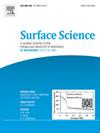用作未来k离子电池阳极材料的r -石墨烯单层膜:DFT研究
IF 1.8
4区 化学
Q3 CHEMISTRY, PHYSICAL
引用次数: 0
摘要
在寻找可持续能源选择的过程中,为钾离子电池(kib)寻找新的、负担得起的、可靠的阳极材料已经成为研究的一个关键焦点。本研究论文提出了一种二维r -石墨炔(R-gyn)单层形式的潜在K阳极材料,并使用第一性原理计算进行了研究。通过分子动力学(MD)模拟验证了R-gyn的稳定性,考察了其结构和热力学。此外,对其电子结构的分析表明,R-gyn单层具有半金属特征。特别值得注意的是R-gyn对钾离子表现出极高的理论比容量(TSC),可达476.32 mAhg−1。显著的容量与相对较小的扩散势垒(95 meV)和有利的开路电压(ocv)在1.61-0.29 V之间配对。所建议的R-gyn材料的这些属性表明,它能够实现高容量的能量存储,并增强钾离子电池中的快速离子扩散。本文章由计算机程序翻译,如有差异,请以英文原文为准。

R-graphyne monolayers as anodic material for future K-ion batteries: A DFT study
In the search for sustainable energy options, finding new, affordable, and reliable anode materials for potassium-ion batteries (KIBs) has become a crucial focus of research. Present research paper presents a potential K anode material in the form of a two-dimensional R-graphyne (R-gyn) monolayer, investigated using first-principles calculations. Stability of R-gyn has been verified through molecular dynamics (MD) simulations, examining both its structure and thermodynamics. Furthermore, an analysis of its electronic structure reveals that the R-gyn monolayer exhibits semi metallic features. Particularly noteworthy is the exceptionally high theoretical specific capacity (TSC) for potassium ions shown by R-gyn, which can reach up to 476.32 mAhg−1. The significant capacity is paired with relatively minor diffusion barriers (95 meV) and advantageous open-circuit voltages (OCVs) ranging between 1.61–0.29 V. These attributes of the suggested R-gyn material suggest its capability to enable high-capacity energy storage and enhance swift ionic diffusion within potassium-ion batteries.
求助全文
通过发布文献求助,成功后即可免费获取论文全文。
去求助
来源期刊

Surface Science
化学-物理:凝聚态物理
CiteScore
3.30
自引率
5.30%
发文量
137
审稿时长
25 days
期刊介绍:
Surface Science is devoted to elucidating the fundamental aspects of chemistry and physics occurring at a wide range of surfaces and interfaces and to disseminating this knowledge fast. The journal welcomes a broad spectrum of topics, including but not limited to:
• model systems (e.g. in Ultra High Vacuum) under well-controlled reactive conditions
• nanoscale science and engineering, including manipulation of matter at the atomic/molecular scale and assembly phenomena
• reactivity of surfaces as related to various applied areas including heterogeneous catalysis, chemistry at electrified interfaces, and semiconductors functionalization
• phenomena at interfaces relevant to energy storage and conversion, and fuels production and utilization
• surface reactivity for environmental protection and pollution remediation
• interactions at surfaces of soft matter, including polymers and biomaterials.
Both experimental and theoretical work, including modeling, is within the scope of the journal. Work published in Surface Science reaches a wide readership, from chemistry and physics to biology and materials science and engineering, providing an excellent forum for cross-fertilization of ideas and broad dissemination of scientific discoveries.
 求助内容:
求助内容: 应助结果提醒方式:
应助结果提醒方式:


